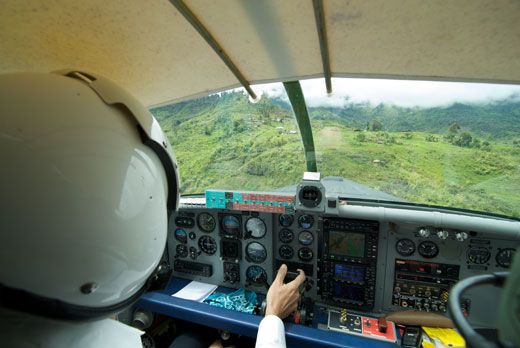Short Strips and Flying Pigs
When flying in Papua, be prepared for surprises.
/https://tf-cmsv2-smithsonianmag-media.s3.amazonaws.com/filer/Flights-Fancy-Sangmata-FLASH.jpg)
The fine folks at Moody Aviation did a standout job of teaching us aspiring missionary pilots how to keep an airplane right side up. But they didn’t teach us everything we needed to know to navigate the jungles—and cultures—in the Indonesian province of Papua. To better prepare young pilots, Moody might do well to consider situations such as:
If someone has ridden in a seat with a bare bottom, do you have to clean the cushion or can you just flip it over?
If a tribal war breaks out around the airplane, do you intervene or join the side that appears to be winning?
Does the seat belt go outside the penis-protector gourd or inside?
Adult pigs, even when secured under a cargo net, are capable of shaking the airplane in flight. What degree of pig-induced vibration is the airplane structurally rated for?
On landing, when one or both brakes fail, what is the proper prayer to recite?
Moody used Cessna 185 Skywagon taildraggers to prepare me to fly Helio Couriers into short mountain airstrips. But flying in remote parts of the developing world is an experience unto itself, and Moody neglected to teach me how to fly while:
Laughing
Crying
Gagging
Panicking
Passengers are screaming
Pigs are screaming
Passengers are screaming because the screaming pigs got loose.
I had to learn all of the above, well, on the fly. My more experienced colleagues in Papua, who showed me the ropes when I first arrived, also withheld vital information, such as:
When a mother hands you her diaperless baby to hold while she climbs in the airplane, if it’s a girl, hold her out at arm’s length; if it’s a boy, hold him out at arm’s length and turn him 180 degrees.
When carrying drums of fuel, the pressure differential between the air in the drum and the air at 5,000 feet will cause the ends of the drum to pop out with a WHAM. If you don’t know it’s coming and your bladder is full, you are in trouble. If you’re lucky, this happens on a day when you’ve already dealt with babies and have been pre-wetted.
While I’m on the topic, when you have to urinate and the only thing handy is a sick sack, always double up. I once filled a bag and was exhaling in relief when my nether regions began to feel unnaturally warm. I lifted the bag to find it was leaking from the bottom corners like a decorative fountain. By the time I got the bag out the window, it had distributed most of its contents all over the cockpit. The experience of explaining the situation to the maintenance team at home base raised another question: Should you trust the airplane to a mechanic who is rolling on the grass, clutching his sides and laughing like a madman?
When frightened, men of the Ketengban tribe—one of the 250 or so tribal groups here—grab their neighbor’s upper thigh and squeeze like an anaconda. This is simply a curious bit of Papuan trivia, unless a tribe member is sitting next to you, in the copilot’s seat, when the fuel drums go WHAM, at which point the gesture generates intense personal concern. Trust me on this one.
Truth be told, the best thing my instructors at Moody imbued me with was a can-do attitude. Trying to prepare oneself for every eventuality in flying is exhausting—and pretty much impossible. Just prepare for the basics and be ready for anything the day may throw at you.
Nate Gordon serves as a missionary pilot in Papua with Yajasi, a partner of JAARS Inc. When he’s not double-bagging sick sacks, he blogs at offthepath.wanderprone.com.
